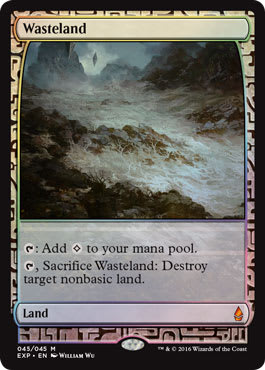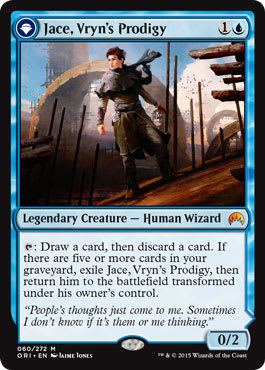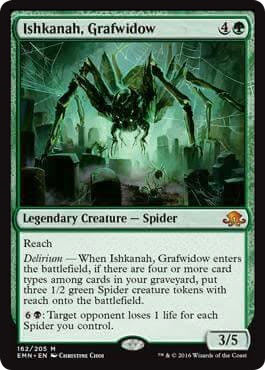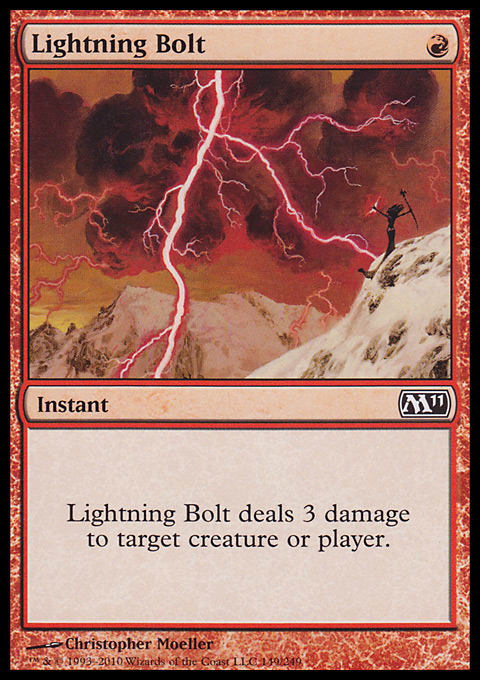Today’s article is going to be a little bit different, because as I write this, the full spoiler for Kaladesh has not been released. Rest assured, I am excited to go over the full spoiler with you all and discuss the constraints in mana and removal that will define the new Standard format. Energy is exciting, Gearhulks are promising, Chandra, Torch of Defiance is either the second or third-best Planeswalker of all time (depends on how you count Liliana of the Veil, because she was weak during her time in Standard), and there are a lot of build-around-me cards just waiting to be broken. I mean, just look at the Fantastic Four of “do-nothing or do-everything” artifacts we get to work with!
Elegant and beautiful! Here is a four-pack of four-cost artifacts that each do basically nothing on their own, but if you build around them, you can do absurd things. If this is Wizards’ new overture to creative Johnny-Spike brewing, then consider me a huge fan. I think that the most breakable is the Orrery, because there are a lot of Madness outlets and payoffs that will allow you to play a normal, synergistic deck. When you get to draw three extra cards and play an extra land every turn, things just might get a little crazy. U/R Fevered Visions/Madness, anyone?
Or hell, make Standard Storm with the Reservoir! If you have enough gas to be casting four or five spells a turn, you can probably make the Reservoir worth it for you. This is a card that might be better-suited for Modern or non-competitive formats, but when you finally do go off with it, this card certainly does light up the opponent.
These may be pipe dreams once Fragmentize becomes a popular sideboard card that ruins your day, but a guy can dream, can’t he?
 Now, all that being said, I am self-aware enough to know that I am way better at tuning decks for an established metagame than I am at brewing up brand-new archetypes, and my understanding of established formats like Legacy and Modern is way more insightful than any shots in the dark that I can make for Standard. Even now, during spoiler season, I tend to gravitate toward card clusters that I already know, clusters that I am comfortable with, rather than boldly setting off in new directions. I know that Elder Deep-Fiend or Distended Mindbender + Kozilek's Return is a huge tempo swing that will remain powerful in the new format, especially if people gravitate toward five-toughness creatures as a way of hedging against Chandra. Neither Temurge nor Jund Delirium will go away completely, as a large portion of the deck’s core remains intact, and Filigree Familiar and Pilgrim's Eye both offer excellent bodies for Emerging. Additionally, both decks get to play Chandra, both for an extra card type and for the obviously powerful effect she brings to the table. Jund Delirium especially looks like a very, very powerful archetype that loses very little with rotation, and I am excited to see how it evolves to combat the new metagame.
Now, all that being said, I am self-aware enough to know that I am way better at tuning decks for an established metagame than I am at brewing up brand-new archetypes, and my understanding of established formats like Legacy and Modern is way more insightful than any shots in the dark that I can make for Standard. Even now, during spoiler season, I tend to gravitate toward card clusters that I already know, clusters that I am comfortable with, rather than boldly setting off in new directions. I know that Elder Deep-Fiend or Distended Mindbender + Kozilek's Return is a huge tempo swing that will remain powerful in the new format, especially if people gravitate toward five-toughness creatures as a way of hedging against Chandra. Neither Temurge nor Jund Delirium will go away completely, as a large portion of the deck’s core remains intact, and Filigree Familiar and Pilgrim's Eye both offer excellent bodies for Emerging. Additionally, both decks get to play Chandra, both for an extra card type and for the obviously powerful effect she brings to the table. Jund Delirium especially looks like a very, very powerful archetype that loses very little with rotation, and I am excited to see how it evolves to combat the new metagame.
But enough about new Standard. I am sure we will have an annoyingly consistent, impossible-to-attack best deck in a few weeks’ time, and everyone will be sick of my minute tweaks and adjustments that supposedly grant you a 5% edge in the soon-to-be ubiquitous mirror matches. If it’s not Tamiyo, Field Researcher replacing Collected Company in Company-less Bant, it’ll be a Delirium deck with unmatched consistency due to the trifecta of Vessel of Nascency, Traverse the Ulvenwald, and Grapple with the Past. For now, let the brews flow, the imagination run wild, and the Vehicles never run out of fuel. In the meantime, I’ll just be over here professing some . . . unusual . . . ideas about some precepts we take as untouchable law when it comes to playing games.
Where should I start? I believe this idea first came to me over four years ago, when I was testing my various Stoneblade concoctions against RUG Delver in Legacy. I thought that I could design a perfectly balanced deck, one with just the right number of main deck and sideboard cards to have a post-sideboard configuration that made me favored against every deck in the format. This was pre-Lands, pre-Deathrite Shaman, and Legacy was a little bit simpler. I remember testing games against one of my oldest Magic friends, Matt Costa, and each of us was absolutely certain that we were a small favorite in the matchup. Ah, the overconfidence of youth!
As we played games, I started to notice something a little bit strange. I was finding myself preferring the games where I was on the draw. I was winning *more* of them! I didn’t know how to reconcile that with the knowledge that “duh, against a Daze-Wasteland deck you definitely want to be on the play!” Yet here I was, winning slightly more of my pre-board games on the draw, and generally finding myself more comfortable playing from the position of parrying my opponent’s plays rather than thrusting with my own. I also loved the fact that I could mulligan on the draw in the matchup, but a mulligan on the play was often a death sentence. Because I was down a card and a half, I would often have to run my plays into my opponent’s answers in an attempt to get ahead on the board, and I would often get Wastelanded out of the game on the play more than I would on the draw. This was certainly unexpected, and I didn’t know exactly what to make of it at the time.
Well, actually, I was so overconfident that I just took it to mean that I would win every game as long as I didn’t mulligan or get manascrewed, and so being on the draw meant that both of those scenarios were less damaging or less likely. I repeat myself, but . . . ah, to be nineteen and feel invincible in what I perceived (and still perceive) to be the most skill-intensive Constructed format. I certainly didn’t lack for self-esteem or confidence in my Magic abilities, that’s for sure!
Fast-forward three years, and the Pro Tour debuted a brand-new mulligan rule designed to mitigate the impact of a mulligan without making it too easy to play inconsistent decks. The Vancouver Scry rule was an absolute home-run, to the point where it’s been seamlessly adopted as a beloved part of the game, almost as integral as the Paris mulligan rule itself. Countless articles were written about the strategic implications of the change, but the message boiled down to a simple “mulligan slightly more loose seven card hands than before, but keep slightly more loose six card hands than before.” Essentially, a low-land hand on six became a keep, and the frequency of non-games involving a double-mulligan by one player dropped significantly.
As players began to develop new heuristics to govern their mulligan decisions with the new scry rule in place, I noticed myself thinking more and more about how in games of Limited, if I was confident in my deck, I would actually prefer to be on the draw in order to mitigate the effects of a mulligan. I thought to myself, “My deck is so great, I’d rather be slightly disadvantaged all the time by being on the draw than be occasionally highly disadvantaged by mulliganning on the play.” This was very, very heretical thinking that I rarely brought up to my peers. I noticed, though, that in slower formats, or with decks that were excellent at catching up on early tempo disadvantages, I almost universally felt more confident on the draw than on the play. I would be scared of having a bad opening hand on the play and being forced to mulligan, but on the draw my scry mulligans seemed almost free.
Perhaps an example will best illustrate my new thought process. With Sultai Emerge in this most recent Standard format, I often considered myself to be so heavily favored against the Bant Company decks I thought that the only way I could lose would be to mulligan and miss on assembling my synergistic interactions or finding a sweeper. Now, I never actually followed through and chose to be on the draw, because I also recognized that my Jace, Vryn's Prodigys were much, much better on the play (as the opponent generally couldn’t hit them with a Dromoka's Command or Reflector Mage before I could flip the Jaces!) However, I was always quite comfortable being on the draw in the matchup, and felt supremely confident if my opponent ever mulliganned on the play. I wasn’t quite ready to commit to taking a different road, especially not in Constructed. After all, who was I to spit in the face of years of Magic wisdom?
Now, Constructed is one beast, but it’s not the only form of high-level Magic out there, and choosing to draw first is way less out of line in Limited than in Constructed. Luckily, a perfect opportunity to try something different unfolded for me this past weekend at the Team Limited Grand Prix. I liked my deck, a grindy little B/G number with some power hitters in Ishkanah, Grafwidow, From Under the Floorboards, and Cryptbreaker, and I mentioned to my teammates I thought I might do better being on the draw. Obviously, in Limited there have already been plenty of formats where being on the draw was preferable, but the general consensus for Eldritch Moon Limited is that you certainly want to be on the play. And here I was, bucking convention because of a half-baked idea about how I was way more comfortable mulliganning on the draw.
Now, to their credit, teammates Ari Lax and Christian Calcano were extremely supportive of my unorthodox rationale. The idea that with the scry rule, being on the draw grants you the opportunity for a “free mulligan” is not generally part of the Magic knowledge pool, but there were several occasions where I won the die roll, my opponent mulliganned on the play, and the win was academic. It’s not that my opponents mulliganned and kept bad hands, either! I just traded cards, saved my hard removal for their best threats, and effectively parried them at every turn. Of course, there were U/W Tempo decks and Red-based aggressive decks that I was worse against for choosing to draw first, but even then, the difference was not quite as huge as one might think. I believe that I won far more games due to having a “free” mulligan than I lost due to being the second to act in that tournament, and I will be on the lookout in the future for more opportunities where being on the draw is actually preferable.
Before the pitchforks come out, let me be clear. In Modern as it currently stands, you do not want to be on the draw. The decks are too fast, the games close out too quickly, and there are too many advantages to getting on the battlefield before your opponent. When Burn wins a Grand Prix on the third turn with a trifecta of Lightning Bolts, this is not the format to buck convention. There are only a few matchups where I might consider choosing to draw first, foremost among them being the Abzan or Jund Midrange mirror. When the removal is more plentiful than the threats, you can choose to be on the draw, but even in these mirror matches, there is a lot to be gained from sticking a Thoughtseize-Dark Confidant-Liliana of the Veil sequence. Let’s not buck convention in Modern. By the same token, if you are playing Legacy, the prevalence of Deathrite Shaman, Miracles, combo decks of various stripes, and the Wastelands and Rishadan Ports of Death and Taxes and R/G Lands decks means that the vast majority of matchups are absolutely about getting a threat on the board before delaying or denying your opponent the ability to play Magic. This is not a format for choosing to be on the draw, unless you somehow find yourself playing an Esper Stoneblade mirror against Shaheen Soorani!
In Standard, though, I believe that there have been plenty of times where we have collectively failed to recognize that we should have been choosing to draw first. In slow control mirrors, being on the draw means you are less likely to miss a land drop. In Thragtusk Jund mirrors circa 2013, being on the draw may have been advantageous considering that both decks came packed with incidental lifegain and the ability to trade off all of their threats quite easily. In a Reflector Mage format, where cards like Tireless Tracker mean that decks do not run out of cards very easily, I’m not too keen on being on the draw, but if and when there comes a time where Standard is not dominated by powerful Planeswalkers (Gideon, Ally of Zendikar new Chandra) and undercosted creatures with mana sink abilities (Duskwatch Recruiter, Tireless Tracker, etc.) let me be the first one you see choosing to draw first at a Grand Prix.
As for Limited? Going forward, I am going to default to choosing “draw first” from now on, unless I find a compelling reason to choose otherwise. If I have a tempo-centric U/W fliers deck, then of course I will choose to play, but if it’s not a particularly fast format and I have a generic grindy B/G or U/B deck? You can bet I’ll be trying to exploit that “my opponent mulliganned on the play and basically started out down two cards” equity for all it’s worth! I intend to gather as much data as I can in every format for which it is at least debatable whether you want to play or draw first, and my hypothesis is that the data will show a higher win percentage for the player on the draw a lot more often than we’d expect.
Now, don’t get me started on the hidden value in having your 16th sideboard card be the 61st card in your maindeck . . .
Until next time, may you enjoy a free Serum Powder every time you lose a die roll!
Ben






























